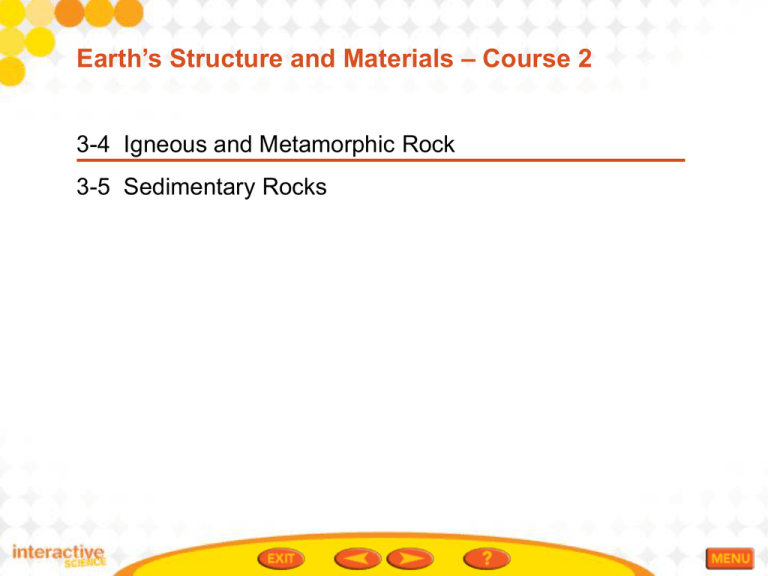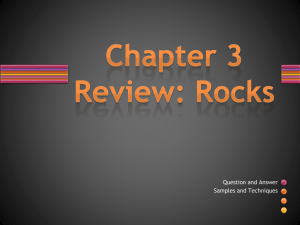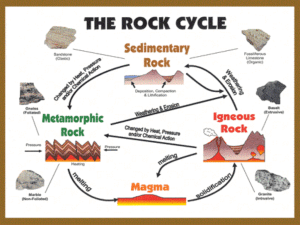File - MrsBlochScience
advertisement

Earth’s Structure and Materials – Course 2 3-4 Igneous and Metamorphic Rock 3-5 Sedimentary Rocks Vocabulary Extrusive Rock- Igneous rock formed from lava that erupted onto Earth’s surface. (Exit) Intrusive Rock- Igneous rock that formed when magma hardened beneath the surface of Earth. (Inside) foliated rock nonfoliated rock Foliated- Metamorphic rocks that have their grains arranged either in parallel layers or bands. Nonfoliated- Metamorphic rocks that have their grains arranged randomly. Rock Dough My Planet Diary pg. 114 Misconception: Rocks Do Not Change Form Did you know that heat can change a rock’s form without melting it? To understand how, think of what happens when you bake cookies. You might mix flour, eggs, sugar, and baking powder in a bowl. When you bake the raw dough in a hot oven, the dough changes into cookies. Heat can change rock, too. If hot magma or lava come near rock, the heat can “bake” the rock. The ingredients in the rock—the minerals—might not melt. But the heat can still change the rock into a new form! Does rock have to melt in order to Change form? Explain. _______________________________ _______________________________ _______________________________ How Do Geologists Classify Igneous Rocks? Pg. 114 Even though all igneous rocks form from magma or lava, igneous rocks can look vastly different from each other. Igneous rocks are classified by their : 1. Origin 2. Texture 3. Mineral Composition. Ignis means “fire” in Latin. What is “fiery” about igneous rocks??? Origin Igneous rock may form on or beneath Earth’s surface. Extrusive rock is igneous rock formed from lava that erupted onto Earth’s surface. •Basalt is the most common extrusive rock. Igneous rock that formed when magma hardened beneath the surface of Earth is called intrusive rock. •The most abundant type of intrusive rock in continental crust is granite. Texture The texture of an igneous rock depends on the size and shape of its mineral crystals. Rapidly cooling lava forms fine-grained igneous rocks with small crystals or no crystals at all. Extrusive rocks have a fine-grained or glassy texture Extrusive fine grained Intrusive Course grained Slowly cooling magma forms coarse-grained rocks, such as granite, with large crystals. . Intrusive rocks have larger grains than extrusive rocks. Lava that is low in silica usually forms dark-colored rocks such as basalt. Magma that is high in silica usually forms light-colored rocks, such as granite. Igneous and Metamorphic Rock – pg. 115 Igneous Rock Origins and Textures The texture of igneous rock varies according to its origin. Did the rocks in the pictures form at A or B? Write your answers in the spaces provided. Mineral Composition – pg. 116 Lava that is low in silica usually forms dark-colored rocks such as basalt. Magma that is high in silica usually forms light-colored rocks, such as granite. Uses of Igneous Rock pg. 116 People throughout history have used igneous rock for tools and building materials. Granite has been used to build statues, fortresses, bridges, and public buildings. Today, thin polished sheets of granite are used in curbstones and floors. Basalt is used for cobblestones and as a material in landscaping and roads. Assess Your Understanding pg. 116 1a. Identify Rhyolite is an (Intrusive, Extrusive) igneous rock. b. Summarize How does rhyolite form? ___________________________________________________ ___________________________________________________ c. Compare and Contrast Rhyolite has a similar composition to granite. Why is the texture of rhyolite different from the texture of granite? ___________________________________________________ ___________________________________________________ What are Metamorphic Rocks? – pg. 117 When great heat and pressure are applied to rock, the rock can change both its and its Any rock that forms from another rock as a result of changes in heat or pressure (or both heat and pressure) is a. How Metamorphic Rocks Form – pg. 117 Pockets of magma can rise through the crust. The high temperatures of these pockets can change rock into metamorphic rock. Collisions between Earth’s plates can also push rock down toward the heat of the mantle. Plate collisions cause great pressure to be applied to rock while mountains are being formed. The pressure can deform, or change the physical shape of, the rock. Under very high temperature or pressure (or both), the minerals in a rock can be changed into other minerals. The appearance, texture and crystal structure of the minerals in the rock change. How Metamorphic Rocks are Classified-pg. 118 Geologists classify metamorphic rocks according to the arrangement of the grains making up the rocks. FOLIATED ROCKS Metamorphic rocks that have their grains arranged either in parallel layers or bands are said to be foliated. Foliated describes the thin, flat layering found in most metamorphic rocks. Crystals in granite can be flattened to create the foliated texture of gneiss. Heat and pressure change the sedimentary rock shale into slate. As shale changes into slate, the mineral composition of the shale can change. How Metamorphic Rocks Are Used- pg. 119 Some metamorphic rocks are nonfoliated. The mineral grains in these rocks are arranged randomly. Marble and quartzite are metamorphic rocks that have a nonfoliated texture. Quartzite forms out of quartz sandstone. Marble usually forms when limestone is subjected to heat and pressure deep beneath the surface. The metamorphic rocks marble and slate are important materials for building and sculpture. Sedimentary Rocks 3-5 How Do Sedimentary Rocks Form? What Are the Three Major Types of Sedimentary Rocks? How Are Sedimentary Rocks Formed? Vocabulary Sediment- Small, solid pieces of material that come from rocks or living things. Weathering- the effects of freezing, thawing, plant roots, acid and other forces on rock that break down the rock into fragments. Erosion –process by which running water, wind, or ice carry away the fragments of broken-up rock. Deposition- the process by which sediment settles out of the water or wind carrying it. Sedimentary Rocks Vocabulary Compaction- the process that presses sediments together Clastic Rock- a sedimentary rock formed when rock fragments are squeezed together. Organic Rock- a sedimentary rock formed with the remains of plants and animals are deposited in layers. Chemical Rock- a sedimentary rock that forms when minerals dissolved in a water solution crystallize. My Planet Diary pg. 120 The Cutting Edge If you had to carve tools out of stone, would you know which rocks to use? Dr. Beverly Chiarulli, an archaeologist at Indiana University of Pennsylvania, studies stone tools that were used by people in Pennsylvania 10,000 years ago. Dr. Chiarulli has found that these people crafted spearheads out of the sedimentary rocks called chert and jasper. Chert is hard and has a very fine texture. It is brittle, but does not fracture along thin, even planes. So, chert can be shaped somewhat easily by flaking off chips, producing the sharp edges needed for spearheads. What properties of chert allow it to be carved into sharp spearheads? ________________________________________ ___________________________________________________ How Do Sedimentary Rocks Form? Pg. 120 Sediment is small, solid pieces of material that come from rocks or living things. Sedimentary rocks form when sediment is deposited by water and wind. Most sedimentary rocks are formed through a sequence of processes: 1. weathering 2. erosion 3. deposition 4. compaction 5. cementation. How Do Sedimentary Rocks Form? Pg. 121 Rock on Earth’s surface is constantly broken up by weathering—the effects of freezing and thawing, plant roots, acid, and other forces on rock. After the rock is broken up, the fragments are carried away as a result of erosion—the process by which running water, wind, or ice carry away bits of broken-up rock. Deposition is the process by which sediment settles out of the water or wind carrying it. The process that presses sediments together is compaction. Cementation is the process in which dissolved minerals crystallize and glue particles of sediment together. Sedimentary Rocks WEDCC How Sedimentary Rock Forms Sedimentary rocks form through a series of processes over millions of years. Sedimentary Rocks What is the proper sequence of the terms in the word bank that will show how mountains can change into sedimentary rock? Assess Your Understanding pg. 121 I get it! Now I know that most sedimentary rocks are formed through the processes of ___________________________________________________ ___________________________________________________ ___________________________________________________ What Are The Three Major Types Of Sedimentary Rocks? Geologists classify sedimentary rocks according to the type of sediments that make up the rock. The are: Clastic 3 major groups of sedimentary rocks rocks chemical rocks organic rocks . 3 Major Types of Sedimentary Rocks – pg 122 A clastic rock is a sedimentary rock formed when rock fragments are squeezed together. Some common clastic rocks are shale, sandstone, conglomerate, and breccia. Organic rock forms where the remains of plants and animals are deposited in layers. Organic rocks include coal and limestone. Chemical rock forms when minerals dissolved in a water solution crystallize. Chemical rocks include limestone and rock salt. Sedimentary Rocks pg. 123 Organic Rocks How do coal and limestone form? Apply It! Pg. 124 These rock “towers” in Mono Lake, California, are made of tufa, a form of limestone. Tufa forms from water solutions that contain dissolved materials. The towers formed under water. They became exposed when the water level in the lake dropped as a result of water needs for the city of Los Angeles. 1. Classify Tufa is a (clastic, organic, chemical) sedimentary rock. 2. Infer What mineral was dissolved in the waters of Mono Lake and later crystallized to form the rock towers? _______________________________________________________ 3. Challenge When acid comes into contact with calcite, the acid bubbles. How can geologists use acid to confirm that the rock towers are made of limestone? _______________________________________________________ _______________________________________________________ Assess Your Understanding pg. 124 1a. Review Shale forms from tiny particles of (clay, sand, mica). b. Describe How is clay deposited to form shale? ___________________________________________________ ___________________________________________________ c. Infer You come across a thick deposit of shale that forms a layer in the ground. What can you infer about the area’s past environment? _______________________________________ ___________________________________________________ ___________________________________________________ How Are Sedimentary Rocks Used? Pg. 125 People have used sedimentary rocks throughout history for many different purposes, including for tools and building materials. Chert and flint were used to make spearheads and arrowheads. Sandstone and limestone are used as building materials. Limestone is used to make cement and steel. Figure 4 Hurricane Monument (Islamorada, Florida) Evaluate the design Do the benefits of constructing monuments out of limestone outweigh the damage acid rain causes them? Explain._____________________________________________ ____________________________________________________ ____________________________________________________ Assess Your Understanding pg. 125 I get it! Now I know that throughout history, people have used sedimentary rocks for ___________________________________________________ ___________________________________________________ ___________________________________________________ The Rock Cycle The Rock Cycle Through melting, weathering and erosion, and heat and pressure, the rock cycle constantly changes rocks from one type into another type. The Rock Cycle Patterns in the Rock Cycle: Surface Events All of the paths of the rock cycle result from only a few surface and subsurface processes. What words belong in the empty boxes in the graphic organizer? The Rock Cycle Surface and Subsurface Events: the Tibetan Plateau Processes on and underneath Earth’s surface drive the rock cycle in mountains on the Tibetan Plateau. The Rock Cycle The Rock Cycle and Plate Tectonics New rock forms on the ocean floor of the Atlantic Ocean, forming a ridge. Here, two plates move apart.








